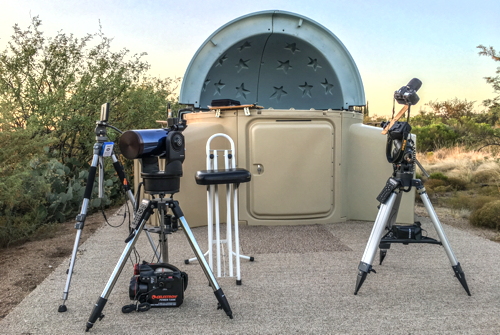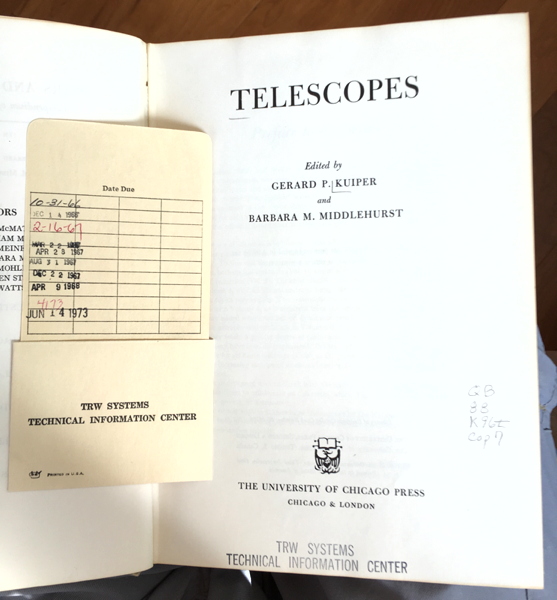Critters; Sick ETX-105PE;
ETX-125AT & Revolution Imager, LXD55 & D7200 DSLR
Posted: 23 June 2016
The weather continued to be hot and hazy/smokey at Cassiopeia Observatory on Monday, 20 June 2016. Some local critters were keeping cool at the "pool", as seen in these three photos taken within about 1 minute:

Click or tap on image for larger version
On the previous session I reported getting "Motor Unit Faults" (MUF) on the ETX-105PE. I suspected (hoped) the external battery power I was using was too weak. I charged the battery overnight and mid-morning on Monday I took the telescope and battery outside to do a TRAIN DRIVES on a distant terrestrial object. But with the fully charged battery I was still getting the MUF error. Further troubleshooting revealed that the altitude drive was not operating. No motor sound at all. Well, rats. But I got over 11 years of use from it. Will have to decide whether to try to repair/replace the drive or just mount the Optical Tube Assembly (OTA) on a different mount. Since the ETX-105PE drive problem could be a circuit board issue and not just a dead motor, I'm leaning towards mounting the OTA on my 13+ year old LXD55 GEM mount using mounting rings, possibly from ScopeStuff. I need to check out the LXD55 mount as I haven't used it in 15 months.
I then took the ETX-125AT outside to do the TRAIN DRIVES on it since it would now be my primary star party telescope. Fortunately, the 16+ year old ETX-125AT worked properly.
Mid-afternoon on Monday, clouds began appearing, wiping out that night's observing and ETX-125AT use. Cloudy skies and the haze/smoke from the still growing Brown Fire continued until Wednesday, 22 June.
|
Open: Wednesday, 22 June 2016, 1903 MST Temperature: 95°F |
Session: 989 Conditions: Mostly clear, breezy |
Equipment Used:
ETX-125AT
1.25" 26mm eyepiece
1.25" 3X TeleXtender
LXD55 GEM
Camera:
Revolution Imager
D7200 DSLR
I set up the ETX-125AT to do some tests of it using the Revolution Imager. I also set up the LXD55 German Equatorial Mount (GEM) to test it out using the D7200 DSLR. Here they are on the observatory patio:

I then SYNCed the observatory clock to WWV time signals.
1938 MST: sunset. ETX ON. Arcturus was visible high overhead so I centered it in the 26mm eyepiece (73X). The second alignment star, Vega, was not yet visible so I accepted it as centered. Did a GOTO Jupiter; it was placed in the finderscope field-of-view (FOV). The view of Jupiter at 73X was good, with three moons visible. I added the 3X TeleXtender for 219X. Good view of Jupiter's cloud bands.
2001 MST: slewed to Spica and SYNCed the AutoStar on it. Viewed Mars, 219X. Nice view of Syrtis Major. Then viewed Saturn, 219X. Fairly good view but clouds were interferring with the view.
2010 MST: took this iPhone 6s Plus photo of the western sky and the ETX-125, the Revolution Imager monitor, and the LXD55/DSLR:

2015 MST: Revolution Imager ON. I began documenting settings for each of the objects I viewed with the Imager. First, slewed to Jupiter and viewed it at prime focus of the ETX-125AT. Good view.
Mars was especially nice with the Imager. Syrtis Major was easily seen, as shown in this iPhone photo of the Revolution Imager monitor:

Saturn wasn't quite as nice but Cassini Division was visible on the monitor (although it doesn't show well in this iPhone photo of the monitor):

I added the Imager focal reducer. By increasing the exposure of the Imager camera I was able to show several of Saturn's moons:

Messier 13, the Great Globular Cluster in Hercules, was a nice object for the Revolution Imager:

2108 MST: due to the increasing clouds I decided to end the Revolution Imager work for this session. I have updated the Revolution Imager settings file (Excel; PDF).
After doing a rough polar alignment of the LXD55 GEM, I took this D7200 DSLR tracked photo of the sky to the southeast showing Saturn, Mars, and the constellation of Scorpius, f/3.5, 15 seconds, ISO 6400, FL 18mm:

Mouseover or tap on image for labels
I need to make an adjustment of the DSLR camera mount before doing more exhaustive tests of the LXD55 in order to decide if mounting the ETX-105 telescope on it is the best solution.
2134 MST: ETX and LXD55 OFF as the sky was mostly cloudy.
|
Close: Wednesday, 22 June 2016, 2204 MST Temperature: 83°F |
Session Length: 3h 01m Conditions: Mostly cloudy, breezy |
I was given a bunch of old astronomy books in April 2016. I just discovered that one of the books was originally from the TRW Technical Information Center:

I worked at TRW beginning in 1984, so this brought back some memories of using the TRW Technical Information Center. The book is volume I of the "Stars and Stellar Systems Compendium of Astronomy and Astrophysics". I bought "Astronomical Techniques (volume II), "Basic Astronomical Data" (volume III), and "Galactic Structure" (volume V) when I was an Astrophysics undergraduate student at Indiana University in the late 1960s. It is nice having another volume in the series.
Comments are welcome using Email. Twitter users can use the button below to tweet this report to your followers. Thanks.
Cassiopeia Observatory Home Page
Copyright ©2016 Michael L. Weasner / mweasner@me.com
URL = http://www.weasner.com/co/Reports/2016/06/23/index.html
